ALGAE
Freshwater and Terrestrial Algae
Algae are simple plants that do not have roots or flowers. Despite all containing green chlorophyll some are red, orange, blue-green or brown.
FRESHWATER ALGAE

© Brian Ecott TQ4792 21/07/2026
Anabaena. A blue-green algal bloom on the lake. It collects in aggregates or flocs around the edges.
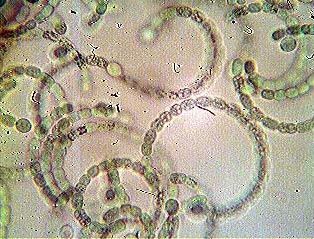
© Brian Ecott TQ4792 21/07/2026
Under the microscope (x400) Anabaena appears as a filamentous alga with similar sized cells occasionally interspersed with a larger heterocyst - looking like a bead necklace.

© Brian Ecott TQ4793 23/07/2026
Euglena. Mud on the edge of Sheepwater having a bright pea-green appearance.
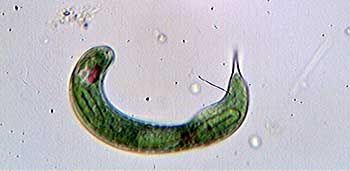
© Brian Ecott TQ4793 23/07/2026
Under the microscope there were masses of motile and non-motile Euglena species. Note the red eye-spot at the anterior end. (x400)
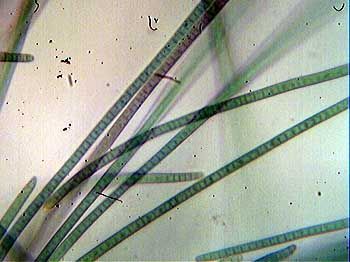
© Brian Ecott TQ4792 23/07/2026
Oscillatoria is another filamentous blue-green alga. This forms blue-green masses in mud. Under the microscope it shows straight filaments of similar cells. The end cell is pointed. Each filament is capable of slowly creeping. (x400) Found in mud near Foxburrows farm.

© Brian Ecott TQ4793 21/04/2026
A Desmid - Pleurotaenium sp. Found in Sheepwater. It is a green alga, and the wavy lines in the middle distinguish this from other desmids. (x400).

© Brian Ecott
TQ4793 23/07/2006
A rigid species of Euglena. Note the red eye spot. Motility is by two anterior flagella. (x400) Sheepwater.
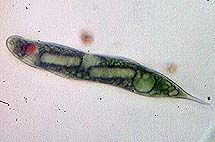
© Brian Ecott
TQ4793 23/07/2006
Another species of
Euglena found in Sheepwater (x400).
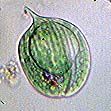
© Brian Ecott
TQ4793 21/04/2026
Phacus sp. Closely related to Euglena. Has flagella and and anterior red eye spot. Sheepwater.(x400)
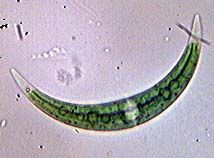
© Brian Ecott
TQ4793 21/04/2006
Closterium sp.

© Brian Ecott
TQ4793 21/04/2006
Closterium sp.
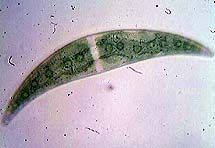
© Brian Ecott
TQ4793 21/04/2006
Closterium sp.
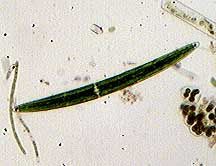
© Brian Ecott
TQ4793 21/04/2006
This Closterium sp. has a very small arc of curvature. (x400). Sheepwater.

© Brian Ecott
TQ4793 21/04/2006
Cosmarium sp.
A Desmid algae consisting of two semi-cells joined in the middle. Found among submerged vegetation in Sheepwater.
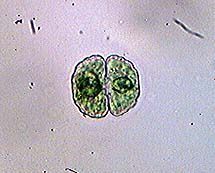
© Brian Ecott
TQ4793 21/04/2006
Cosmarium sp.
Another Desmid algae found at Sheepwater.
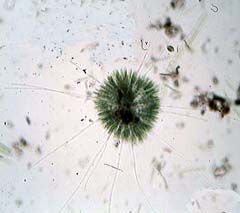
© Brian Ecott
TQ4793 21/04/2006
Chaetophora sp. is a green alga, epiphytic on water plants.(x100). Sheepwater.

© Brian Ecott
TQ4793 21/04/2006
Chaetophora sp.
Branched filaments (x400) form tufts or balls from which long colourless hairs protrude
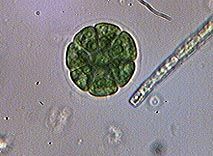
© Brian Ecott
TQ4793 21/04/2006
Pandorina sp. a motile, colonial green alga consisting of 8 -16 cells. Each cell has two flagella and the colony is enclosed in a mucilage layer. Sheepwater.
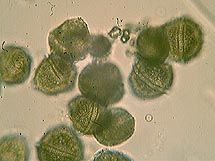
© Brian Ecott
TQ4793 21/04/2006
Peridinium sp. a Dynoflagellate. Found at Sheepwater.
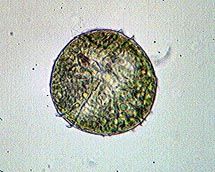
© Brian Ecott
TQ4793 21/04/2006
Peridinium sp.
Free swimming cells move with a whirling motion due to two flagella which lie in the grooves of the armoured cell.

© Brian Ecott
TQ4793 21/04/2006
Pediastrum sp.
a non-motile green alga. May consist of 8,16 or 32 cells. Found at Sheepwater.
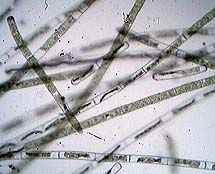
© Brian Ecott
TQ4793 21/04/2006
Mougeotia sp. is an unbranched filamentous green alga. (x100) The chloroplast in the cell is flat and can often be seen end on. Roe's Well.
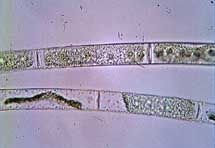
© Brian Ecott
TQ4793 21/04/2006
Mougeotia sp. (x400) Sheepwater.
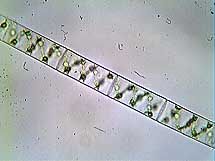
© Brian Ecott
TQ4793 21/04/2006
Spirogyra sp. in Roe's Well. Unbranched filamentous green alga with the chloroplast in a spiral within the cell. (x400)
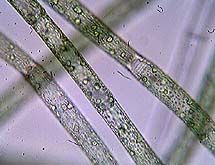
© Brian Ecott
TQ4691 21/04/2006
Oedogonium sp. in Hainault Lodge Pond. Unbranched filamentous green alga. Attached to edges of ponds and plants. The end of the terminal cell is usually rounded. The chloroplast is net-like in each cell. (x400)
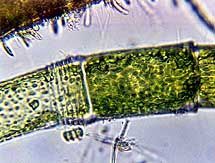
© Brian Ecott
TQ4691 21/04/2006
Oedogonium sp. A characteristic is the presence at the end of some cells of ridges like a stack of disposable cups (x950).
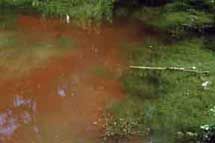
© Brian Ecott
TQ4793 13/04/2003
Haematococcus sp.
in Roe's Well is unicellular green alga containing a blood red pigment which colours the water red. The green mass is stonewort
Chara vulgaris vulgaris.
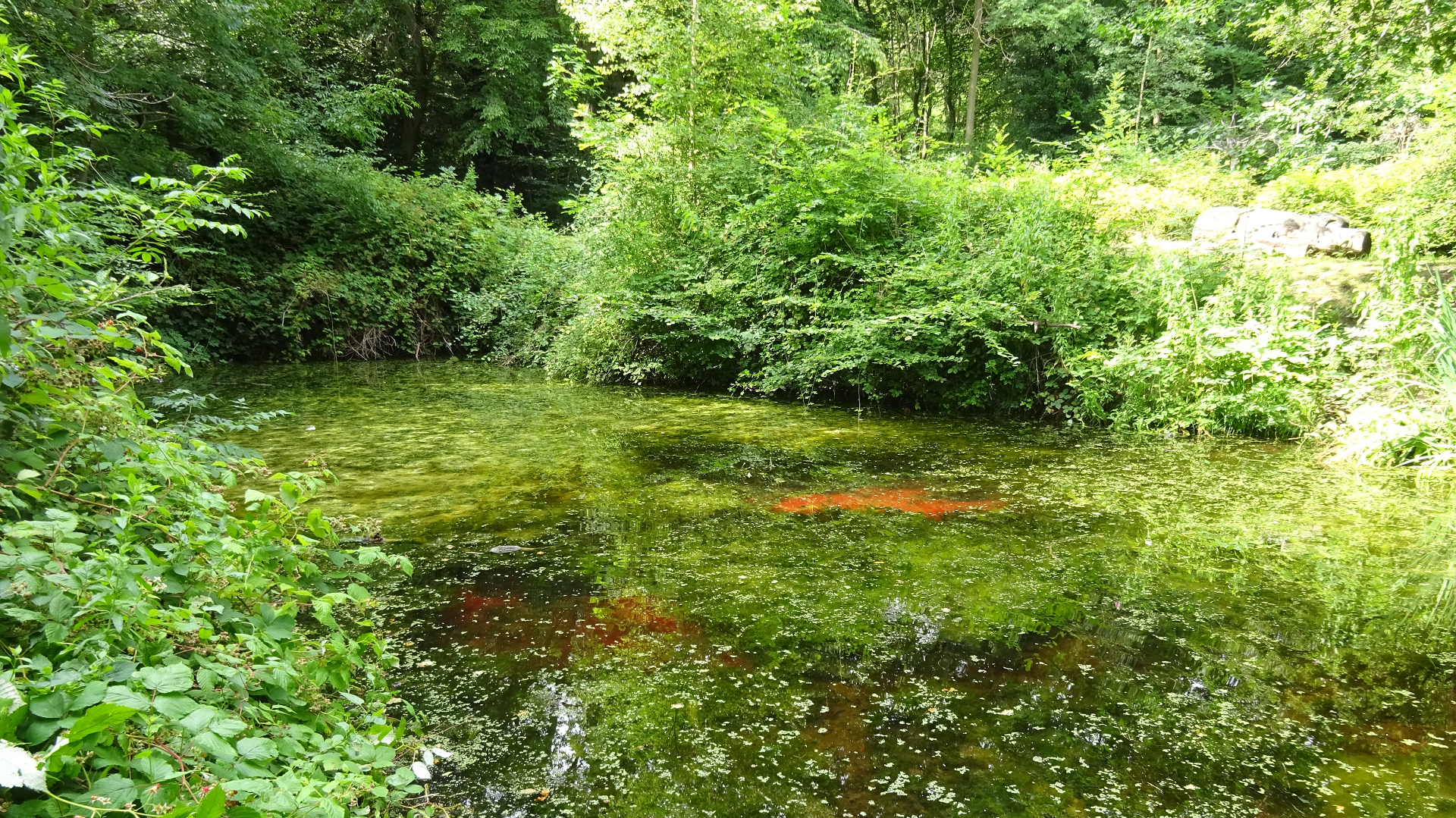
© Raymond Small TQ4793 12/07/2017
Red patches of single-celled green algae Haematococcus sp.
which contain a blood red pigment.
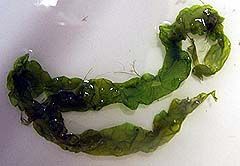
© Brian Ecott
TQ4792 17/05/2006
Enteromorpha flexuosa pilifera. Length of this specimen 20cms x 12mm width. Attached to rock near outflow of the Lake. Likes nutrient rich water. Often found in marine environments.
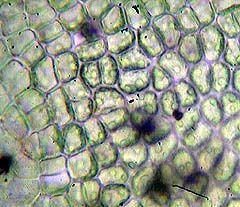
© Brian Ecott
TQ4792 17/05/2006
Enteromorpha flexuosa pilifera. A hollow tube, one cell thickness. Detail above x950.
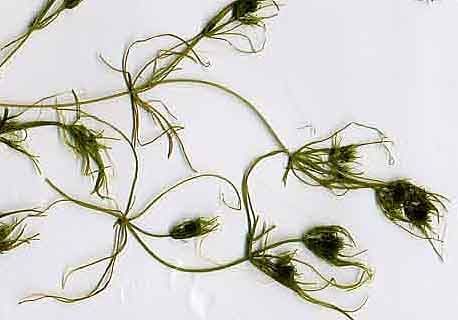
© Brian Ecott
TQ4793 13/04/2003
Chara vulgaris vulgaris - a Stonewort which is present in Roe's Well. Stoneworts are macroscopic green algae which get their name from the presence in them of Calcium carbonate.

© Brian Ecott
TQ4792 21/04/2006
Cladophora sp. on rock in lake edge is a branched filamentous green alga(x100). Hainault Lake.

© Brian Ecott
TQ4792 21/04/2006
Cladophora sp. Often free floating where it gets the name Blanket weed. It feels rough to the touch due to the many species of Diatom which attach themselves to it. (x400)

© Brian Ecott
TQ4792 21/04/2006
Cladophora sp. Diatoms are brown algae with silica shells. (x950).
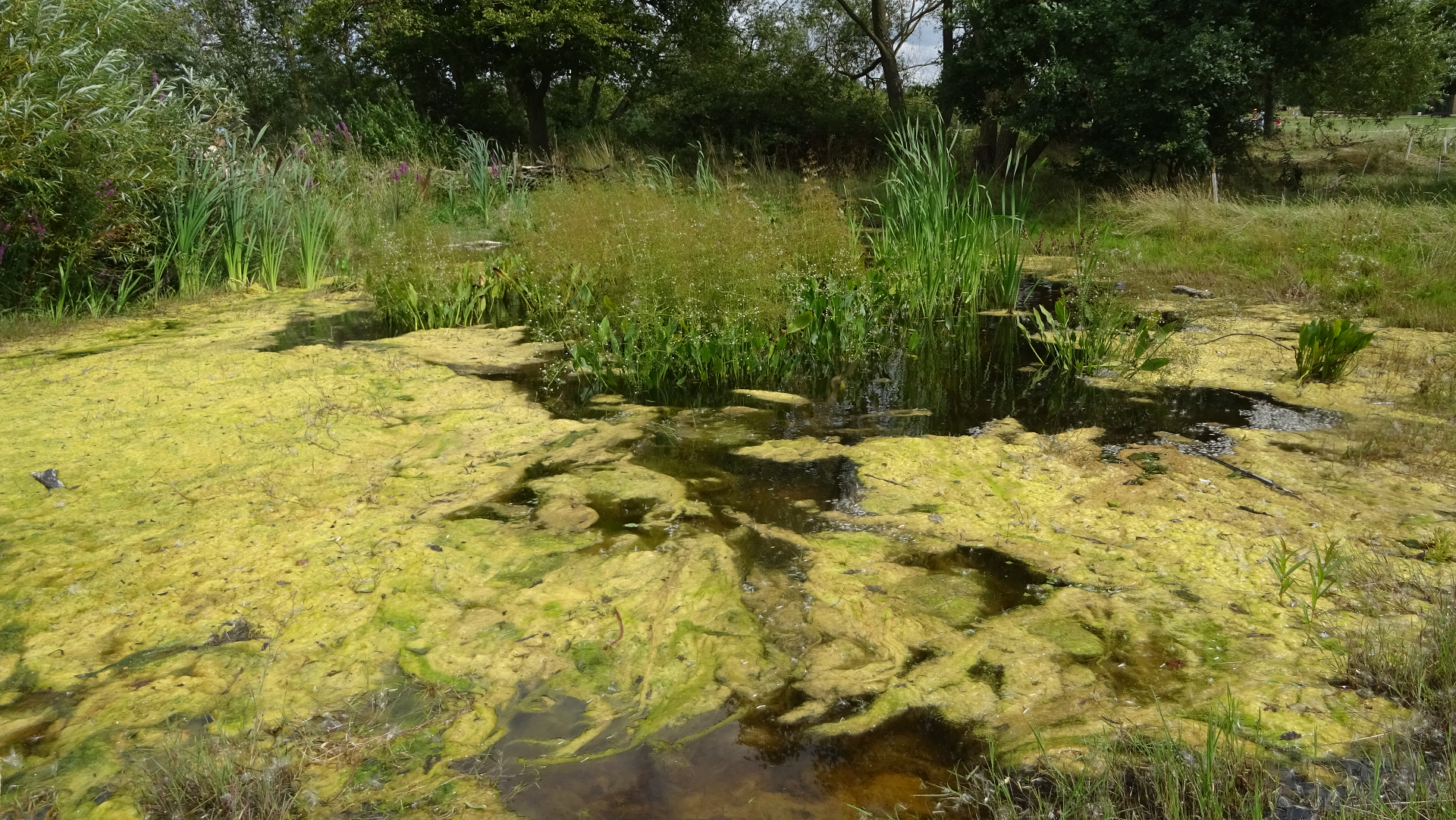
© Raymond Small TQ4792 11/08/2023
Blanket weed Cladophora sp.
appears in warmer months to cover ponds and is especially common when located in direct sunlight. This particular algae is a filamentous species, commonly referred to as 'String algae', or 'Silk weed'.
TERRESTRIAL ALGAE
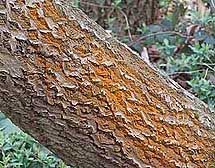
© Brian Ecott
TQ4793 23/03/2005
Trentepohlia sp.
on Ash tree near Sheepwater forming orangey tufts. It is a green alga with an orange pigment.
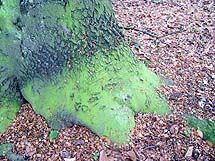
© Brian Ecott
TQ4792 16/05/2006
Desmococcus olivaceum a green alga on tree trunk. Formerly known as Pleurococcus, it consists of 1,2,3 or cell clusters on the shaded part of trees.
On Dog Kennel Hill.

© Brian Ecott
TQ4792 30/12/2004
Nostoc commune
on hoggin path near Foxburrows cottages. This is a macroscopic blue-green algal colony.
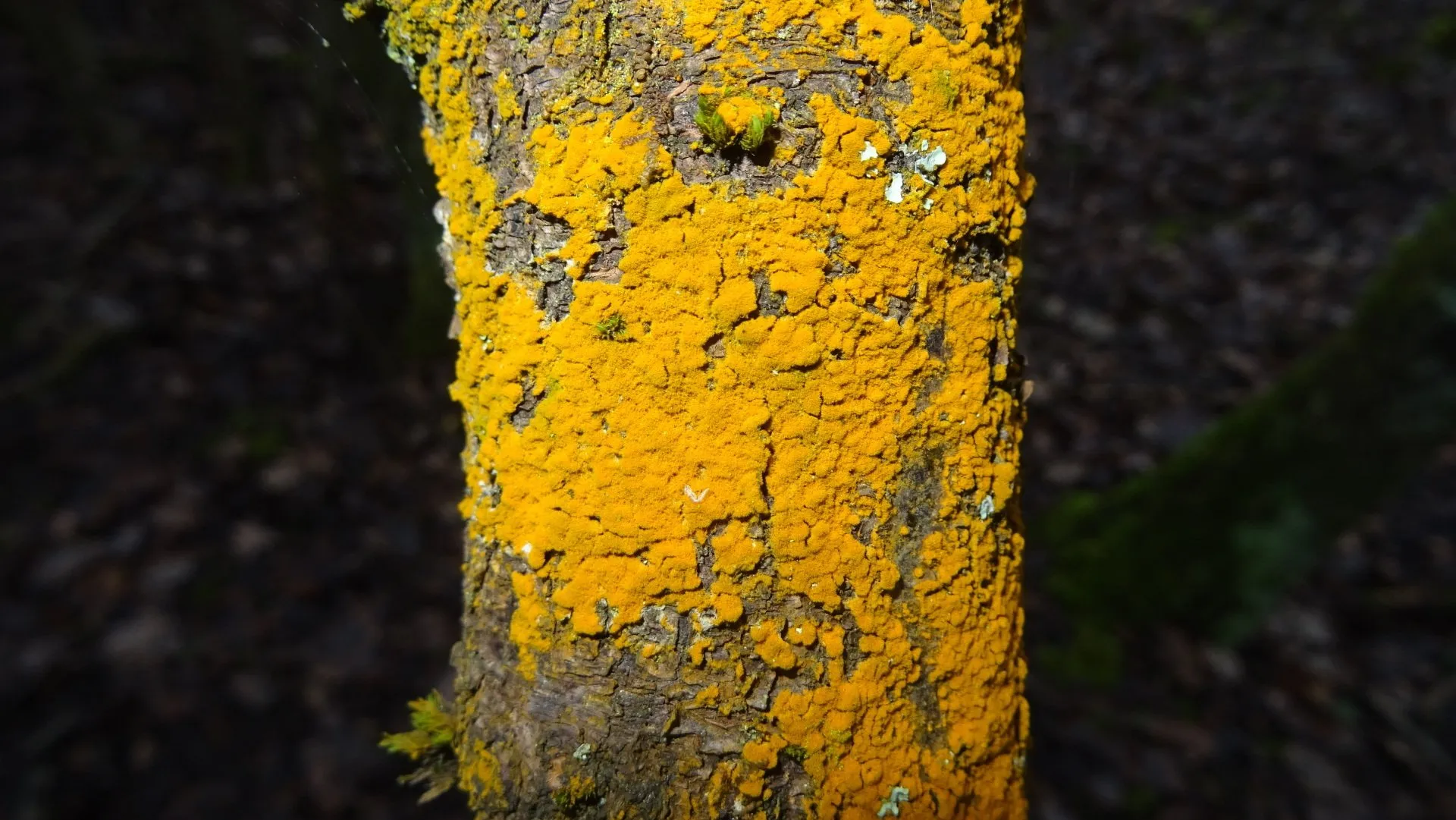
© Raymond Small TQ4792 19/01/2022
This distinct orange colouration on tree trunks is caused by a genus of filamentous green algae
Trentepohlia sp. Carotenoid pigments mask the green of chlorophyll so that the algae appear orange. These are similar pigments to those found in carrots. The algae often have a symbiotic relationship with lichens. There are several species that are often treated as an aggregate when recording.
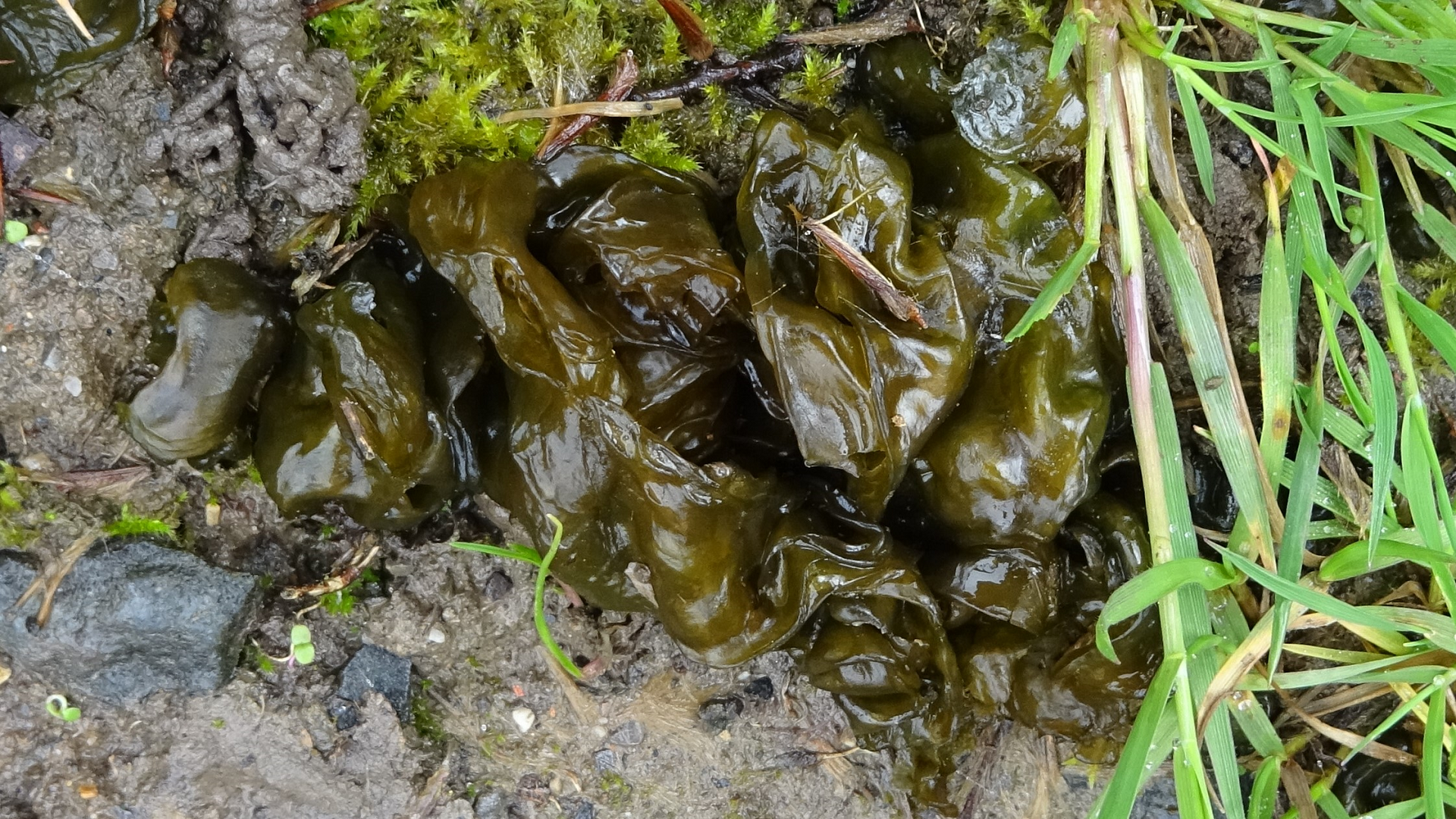
© Raymond Small TQ4792 10/04/2018
Nostoc commune was a very early form of life on Earth thought to date back 3.5 million years. It is a communal blue-green alga found on paths and bare earth, that is also known as a prokaryote or cyanobacterium. The cells do not contain a nucleus and all its genetic material is spread throughout the cell. From fossil evidence they were present on earth before oxygen had evolved and were able to fix nitrogen.
© hainaultforest.net. All rights reserved.

